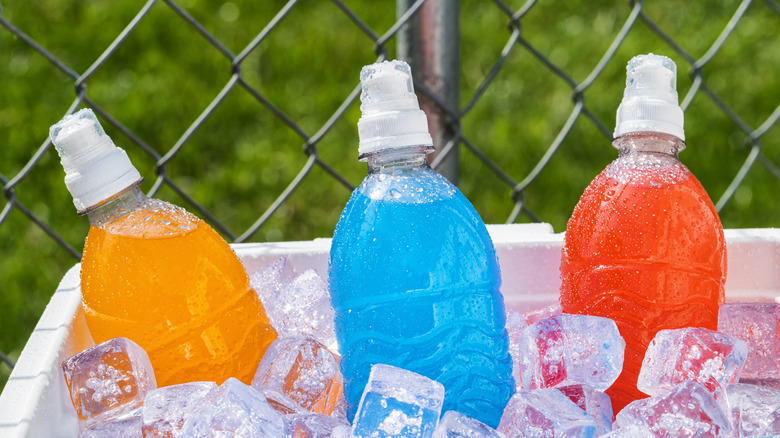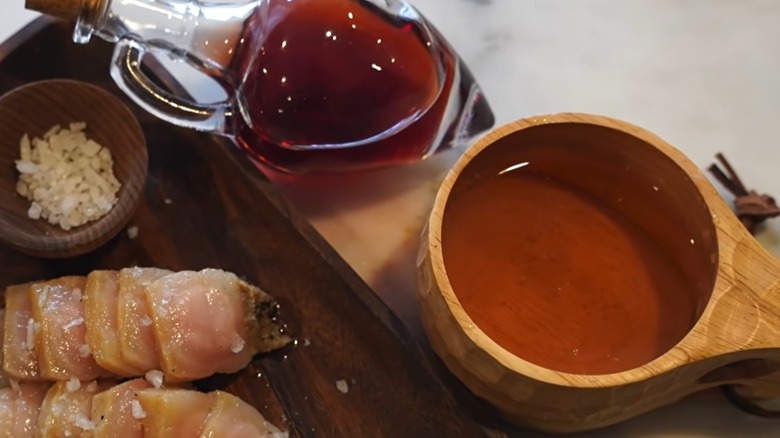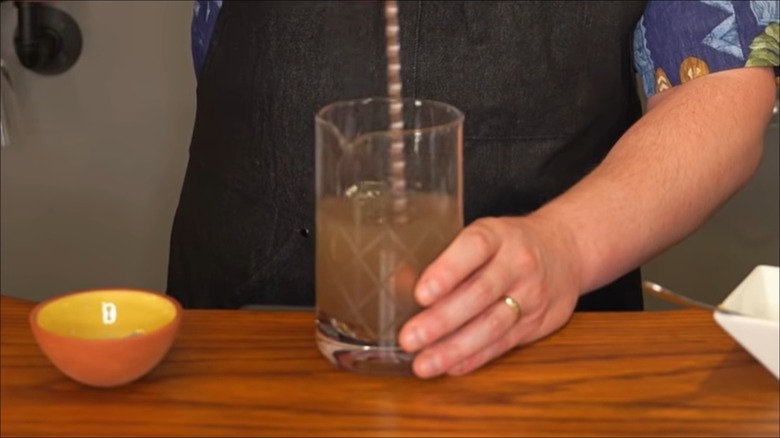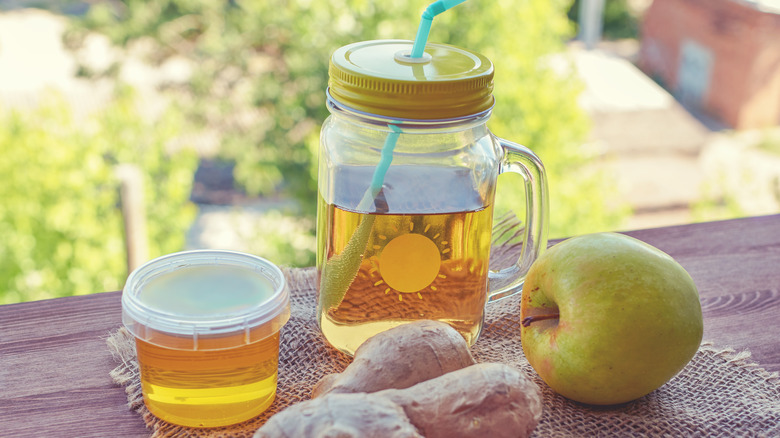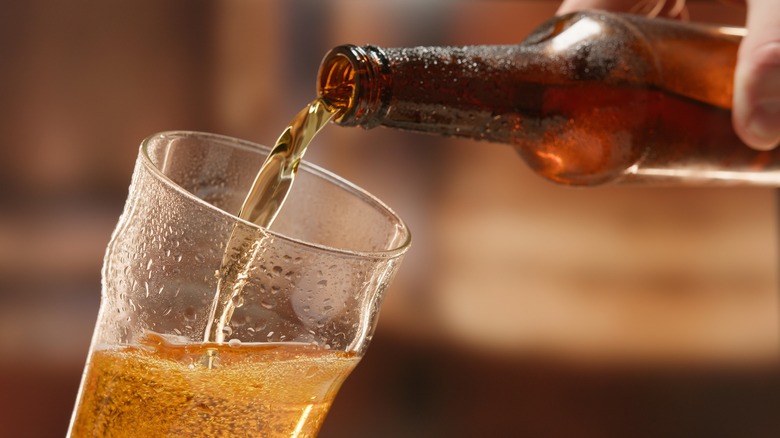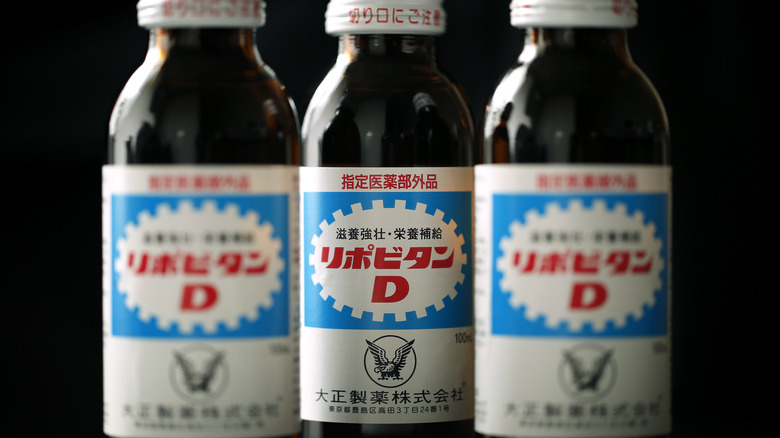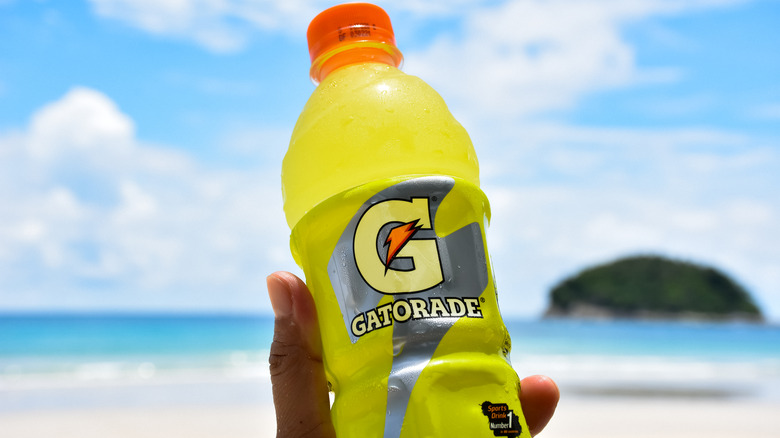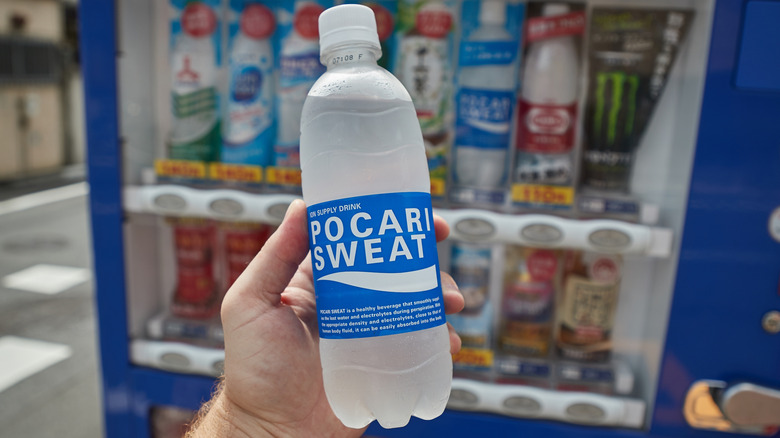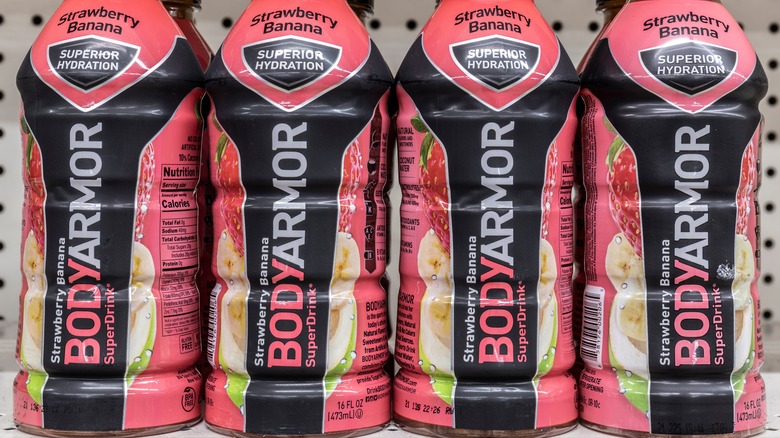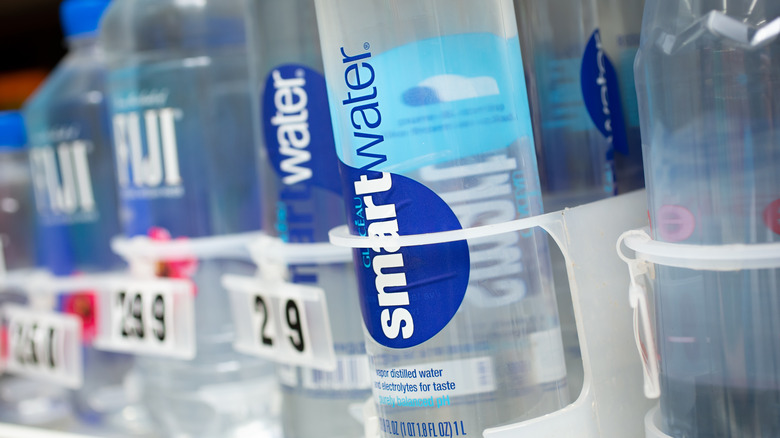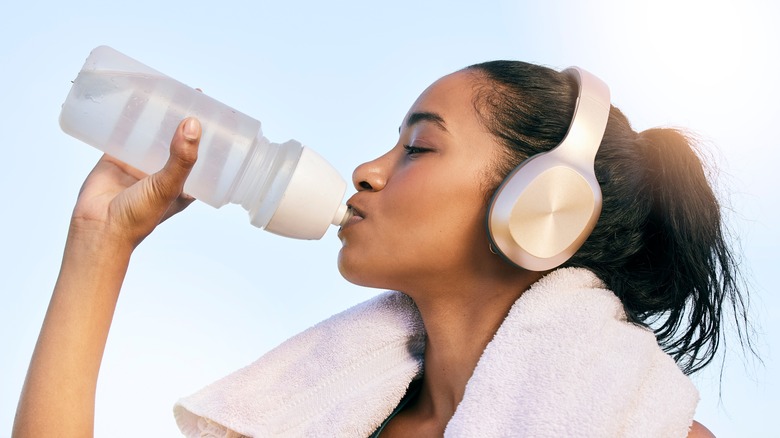The Strange Untold History Of Sports Drinks
If you were asked to give examples of sports drinks and energy drinks, you could likely come up with plenty of examples. Gatorade and Powerade are obviously sports drinks containing vital nutrients like electrolytes to rehydrate the body while targeting athletes and marathon runners. Red Bull and Monster include stimulants like taurine and caffeine to give a boost of energy, though they may also contain essential vitamins and minerals. In the past, the distinction between sports drinks and energy drinks wasn't so cut and dry. What replenished you was also meant to bring back your energy.
What's more, there are three different kinds of hydrating fluids: hypotonic, isotonic, and hypertonic. These terms mean that the beverage contains lower, similar, and higher (respectively) concentrations of fluid, salt, and sugars than human blood. Each one should be consumed at different parts of your workout. The fact that science has figured out how this all works is pretty impressive.
Yet humans have intuited how to replenish vital nutrients when exerting themselves for millennia. Join us below as we dive into the surprisingly long history of sports and energy drinks.
Roman soldiers relied on posca
Ancient Rome has always been pretty famous for its elite and formidable military might. Organized into legions, these forces marched across much of the ancient world, from Europe to Asia, conquering those who opposed them.
Keeping these thousands of foot soldiers and cavalrymen fit was no easy task. One of things that the Roman legions relied on was a specially mixed beverage called posca. The main ingredients for posca were sour wine, vinegar, and water. The addition of different herbs and spices such as coriander seeds, or sweeteners like honey, helped to counter the initial acidic, sour flavor.
While this may not sound the most appetizing to a modern palate, there were, in fact, several health benefits of posca. Much like sports drinks of today, posca contained antioxidants such as vitamin C, and may have helped reduce swelling in the body as well as lower blood sugar. The acid killed dangerous bacteria commonly found in drinking water at the time, making posca safer to drink than straight water.
A beverage that is very similar to posca and still popular in Iran all these centuries later is sekanjabin, which uses red wine vinegar and sugar as its base.
Gladiators had their own sports drink
Ancient Romans were not just a lean, mean military force. Roman civilians were also really into fighting, or at least they enjoyed watching other people fight. Gladiatorial events were hugely popular throughout Ancient Rome, and as such, the gladiators were virtual celebrities. In order to maintain their rock star lifestyles, gladiators needed to be in top physical form or risk serious injury ... or even death.
Unlike posca, the gladiators' drink of choice doesn't seem to have a specific name. It is often simply referred to by modern people as "Gladiator Gatorade." While examining the remains of gladiators from a cemetery in the ancient city Ephesus (located in modern-day Turkey), experts discovered that ancient fighters imbibed a beverage made from plant ash. Such a drink was described by Pliny the Elder, who claimed gladiators drank the special brew after fights to alleviate pain. It was rich in calcium, an important mineral for maintaining healthy bones.
How precisely the ash was imbibed is not really known. It could have been mixed with water or added to posca. While it is still possible to obtain culinary ash, you may want to stick to modern sports drinks and leave this one buried in the past.
Early Americans drank switchel
We're going to jump ahead a millennium or so and make a stop in the Americas post-European colonization. Switchel, also known as Haymaker's Punch, is a blend of water, apple cider vinegar, freshly grated or ground dried ginger, and either maple syrup or molasses depending on which sweetener was easier to come by in the region. It was just the thing to slake one's thirst during a long, hard day of laboring in the sun.
Similar to the vinegar in Ancient Rome's posca, the apple cider vinegar would have helped kill harmful bacteria in the water used to make switchel. It also would have provided antioxidants to reduce swelling in the body, vitamins, amino acids, and other healthy compounds. Maple syrup also contains antioxidants, calcium, iron, potassium, and more, plus it is high in manganese, which supports healthy bones. Ginger is also full of antioxidants and has been used as a home remedy for a variety of ailments by many different cultures for centuries.
Some athletes preferred beer
Around the turn of the 20th century, popular opinion was that athletes should refrain from eating or drinking anything while exercising or competing. As we have seen, this runs counter to what humans had been doing for thousands of years, so we're not sure what these folks were thinking.
There was — and in some cases, still is — a significant portion of the sports community that enjoyed a good pint after a round of golf, or a football match, or in the middle of cycling the Tour de France. The same could be said for people today who kick back with a cold beer after a long day in the sun. But is beer an appropriate sports drink?
Throughout history, the alcohol in beer killed off disease-causing elements in poorly filtered water, making it safer, not to mention more popular, to drink than water alone. Beer also contains antioxidants, carbohydrates, sodium, and potassium. Alcohol, however, is a diuretic which is not conducive to great rehydration. A beer with a lower alcohol content would seem to be the most beneficial type to imbibe, but in the modern age of well-filtered water, the beer can wait until after your body recovers from a strenuous workout.
Europe and Asia had the first commercial energy drinks
As we said, humans throughout history were more concerned about replenishing their energy after physical exertion than tying any one beverage specifically to sports. Perhaps this is why energy drinks hit store shelves a few years ahead of sports drinks.
Taisho Pharmaceuticals began selling Lipovitan D in Japan in 1962. This medicine-like herbal restorative was intended to give those who drank it a boost both physically and mentally. Unsurprisingly, taurine was one of Lipovitan D's main ingredients. Due to its instant popularity, energy drinks quickly spread beyond Japan's borders.
In Thailand, Krating Daeng emerged around 1976. Created by Chaleo Yoovidhya, Krating Daeng included both taurine and caffeine as well as B vitamins to give drinkers an energy boost. Dietrich Mateschitz, an Austrian businessman, encountered these energy drinks while visiting Bangkok and was impressed by their effectiveness. In 1984, he partnered with Krating Daeng to bring the drink to Europe. The name was translated from Thai to "Red Bull." Finally, Red Bull hit the U.S. market in 1996, and the rest was history.
Gatorade became the first official sports drink
While Asia and Europe were going wild over energy drinks, Americans were working on inventing a beverage specifically targeting athletes. Yes, we have finally arrived at Gatorade.
In 1965, University of Florida assistant football coach Dewayne Douglas tasked scientists on campus to come up with a way to help his football players withstand the intense Florida heat. The solution was a beverage that contained salts and sugars that would be easily absorbed by the body to help with rehydration. By all accounts, the initial batch was not a success, and it was not well received by the players. Some may have even thrown it up. But the kinks were worked out, and now Gatorade is one of the top sports drinks in the world. The first flavor, lemon-lime, was joined by other flavors after Quaker Oats acquired the brand in the early '80s.
The name Gatorade comes from the gator mascot of the University of Florida. The suffix "-ade" is often added to a word to denote a sweet drink, such as lemonade and limeade. Ade also rhymes with aid, adding an element of helpfulness to the name.
Pocari Sweat dominates in Asia
We need to head back to Japan for a minute because no history of sports drinks would be complete without Pocari Sweat, which hit Japanese grocery shelves in 1980. Just two years later, Pocari Sweat reached Hong Kong and Taiwan and the Middle East. Now it's one of Asia's most popular sports drinks.
After Otsuka Pharmaceuticals employee Rokuro Harima observed an exhausted doctor attempting to rehydrate by drinking from an IV bag, he was inspired to create a beverage for that same purpose. Otsuka already produced IV solutions for hospitals as well as energy drinks like Oronamin C, so a sports drink wouldn't be out of place. Pocari Sweat is made of water, sugar, citric acid, magnesium, calcium and sodium. Pocari doesn't have a particular meaning, but sweat is a direct reference to what the drink is meant to replace — the hydration that is sweated out of the body during physical exertion.
Unlike Western drinks like Gatorade and Powerade, Pocari Sweat comes in only one flavor, a little sweet and slightly salty with a dash of citrus. It is marketed to remedy dehydration from any cause, from aerobic exercise to hangovers.
Coca-Cola bet against itself with BodyArmor
The Coca-Cola Company designed and marketed Powerade, which launched in 1988, as a direct competitor to historic rival PepsiCo's Gatorade. Not content with a brand that has become the official drink of dozens of sports leagues the world over, Coca-Cola decided to acquire BodyArmor, another popular sports drink, in 2021.
BodyArmor is fairly new compared to others on this list, only created in 2011 by Mike Repole. The brand advertises itself as being preservative free and using only natural flavors, colorants, and sweeteners. Having no added sugar means that an 8-ounce serving of BodyArmor contains roughly half the amount of sugar as 8 ounces of both Gatorade and Powerade.
When Coca-Cola first purchased a partial stake in BodyArmor in 2018, it took its first steps in investing in one of Powerade's top competitors. Intaking full control, Coca-Cola was in charge of convincing consumers of Powerade to switch to BodyArmor. Each drink has its own mix of vitamins and minerals, but BodyArmor is generally priced higher than Powerade. So perhaps persuading its own consumers to choose the more expensive brand wasn't such a bad deal after all.
Smartwater, the sugarless sports drink
Launched in 1996 by J. Darius Bikoff, Smartwater is vapor-distilled tap water that has been enhanced by the addition of electrolytes to boost hydration. The vapor-distillation process removes minerals from the water, which some believe makes it less nutritious than the pre-distilled water. However, because of its much shorter ingredients list, Smartwater is potentially a more healthful choice than sugary sports drinks.
While Smartwater is not technically considered a sports drink, it is imbibed by many people involved in sports for the purpose of rehydration and recovery. In a society increasingly concerned with streamlining fitness and removing adulterations like dextrose (Gatorade's sweetener) and high fructose corn syrup (used to sweeten Powerade), it makes sense for a product built on creating a better hydrating form of water to be the ultimate evolution of all of these sport drinks.
On the other hand, the same creators of Smartwater also made Fruitwater and Vitaminwater, so perhaps the story isn't over after all.
The future of hydration
When you consider that humans have been tinkering with various fluids to create safer and more refreshing beverages to swig after a hearty bout of physical activity for thousands of years, the future of sports drinks and other enhanced waters seems assured. In fact, despite emerging evidence that sports drinks may not actually be all that good for us, Future Market Insights is pretty confident the global sports drink market will continue to grow considerably.
One of the reasons for such variety throughout history, not to mention the 21st century sports drink market, is that every one of our bodies behaves differently. There is no magic recipe that will perfectly rehydrate all of us equally. But maybe we don't need one. In theory, the future of sports drinks could be in an increased focus on individualization. As far as what exactly that would look like, we'll just have to wait and see.
